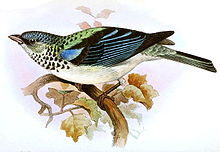Cabanis's tanager
| Cabanis's tanager | |
|---|---|
 |
|
| Scientific classification | |
| Kingdom: | Animalia |
| Phylum: | Chordata |
| Class: | Aves |
| Order: | Passeriformes |
| Family: | Thraupidae |
| Genus: | Tangara |
| Species: | T. cabanisi |
| Binomial name | |
|
Tangara cabanisi (Sclater, 1866) |
|
The Cabanis's tanager or azure-rumped tanager (Tangara cabanisi) is a Middle American bird of the family Thraupidae. It is a local resident in humid broadleaf forests and adjacent plantations of the Pacific slope of western Guatemala and southern Chiapas, Mexico. It has been reported at elevations of 850–1,900 m (2,790–6,230 ft).
Its plumage is mostly pale blue, with a purplish-blue crown, distinctive dark spots across the chest, dark lores and lower auriculars. The mantle is mottled greenish-blue and black. The wings and tail are black with blue edgings. The bill is gray with a dark tip. Cabanis's tanagers utter several sibilant vocalizations, hard trill and twitters.
The Cabanis's tanager is omnivorous, feeding on fruit and arthropods. In Guatemala, abundance was positively correlated with the density of Ficus aurea trees. Figs of that tree are a main food source. The nesting season ranges from April to September, during which Cabanis's tanagers move in pairs or family groups. Cooperative breeding has been reported. Outside the breeding season, larger flocks of up to 18 birds have been reported.
Cabanis's tanager is endangered because of deforestation to clear the way for coffee plantations. In Guatemala, only 21% or 25,000 ha (62,000 acres) of the potential area of distribution are still covered with broadleaf forest, the tanager’s prime habitat. 80000 ha or 68% of the potential area of distribution is covered with coffee plantations. It is estimated that there are 8250–23250 birds left in Guatemala. For Chiapas, there is no recent estimate, but in the 1980s there were 112000 ha of suitable habitat, which is expected to be much smaller now due to a growing human population and increased pressure by agricultural activities
This species was named in honour of Jean Cabanis.
Its closest relative appears to be the similarly-pattered grey-and-gold tanager.
...
Wikipedia

